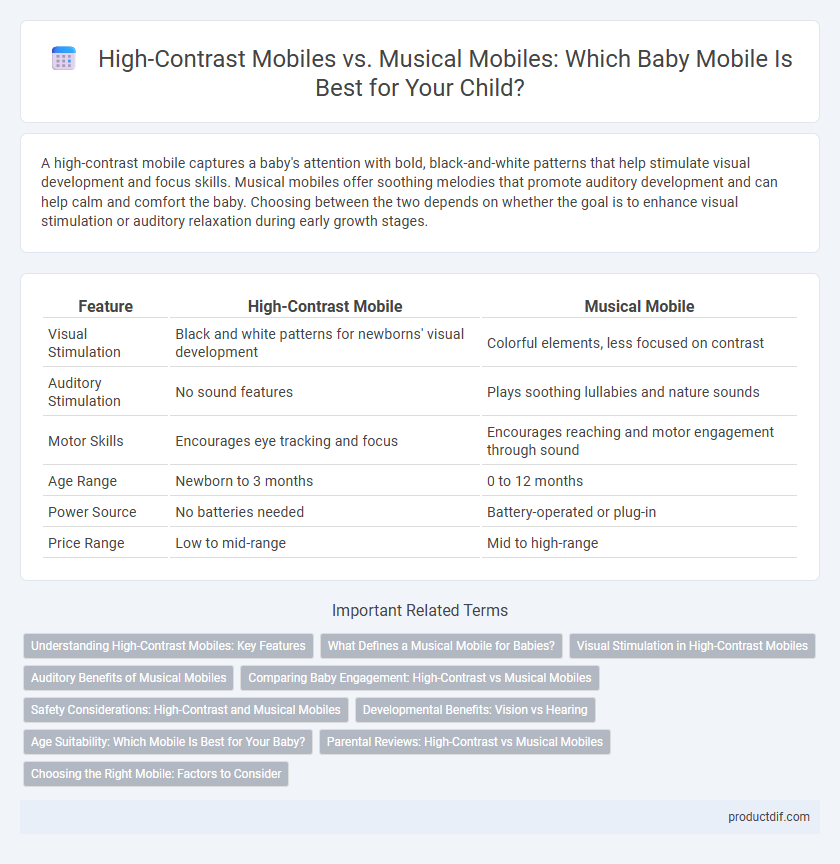A high-contrast mobile captures a baby's attention with bold, black-and-white patterns that help stimulate visual development and focus skills. Musical mobiles offer soothing melodies that promote auditory development and can help calm and comfort the baby. Choosing between the two depends on whether the goal is to enhance visual stimulation or auditory relaxation during early growth stages.
Table of Comparison
| Feature | High-Contrast Mobile | Musical Mobile |
|---|---|---|
| Visual Stimulation | Black and white patterns for newborns' visual development | Colorful elements, less focused on contrast |
| Auditory Stimulation | No sound features | Plays soothing lullabies and nature sounds |
| Motor Skills | Encourages eye tracking and focus | Encourages reaching and motor engagement through sound |
| Age Range | Newborn to 3 months | 0 to 12 months |
| Power Source | No batteries needed | Battery-operated or plug-in |
| Price Range | Low to mid-range | Mid to high-range |
Understanding High-Contrast Mobiles: Key Features
High-contrast mobiles feature black-and-white patterns specifically designed to capture newborns' developing vision and stimulate neural pathways essential for cognitive growth. These mobiles typically include geometric shapes with stark contrasts that encourage visual tracking and focus, enhancing early visual perception skills. Unlike musical mobiles, high-contrast mobiles prioritize visual stimuli over auditory engagement, making them crucial for sensory development during the first few months of life.
What Defines a Musical Mobile for Babies?
A musical mobile for babies integrates melodic sounds or lullabies to stimulate auditory development alongside visual engagement. These mobiles often feature rotating figures synchronized with soothing tunes that help calm infants and encourage sensory exploration. The combination of music and motion distinguishes musical mobiles from high-contrast mobiles, which primarily focus on visual contrast to enhance early vision skills.
Visual Stimulation in High-Contrast Mobiles
High-contrast mobiles use bold black-and-white patterns designed to capture and hold a newborn's attention, enhancing early visual development by stimulating the retina and brain's visual pathways. Unlike musical mobiles, which primarily engage auditory senses, these mobiles focus on visual contrast to improve focus and eye-tracking skills. Research shows that high-contrast visuals promote quicker recognition and cognitive growth in infants during their first months.
Auditory Benefits of Musical Mobiles
Musical mobiles provide essential auditory stimulation that supports early language development and sensory integration in infants. Unlike high-contrast mobiles that primarily engage visual tracking, musical mobiles enhance auditory processing and promote calming effects through rhythmic sounds. Exposure to varied melodies and tones helps improve babies' auditory discrimination and cognitive connections related to sound recognition.
Comparing Baby Engagement: High-Contrast vs Musical Mobiles
High-contrast mobiles stimulate newborns' visual development by featuring bold black-and-white patterns that capture infants' attention more effectively in early months. Musical mobiles engage babies through auditory stimulation, promoting cognitive development and soothing effects via melodies and rhythms. Comparing baby engagement, high-contrast mobiles are ideal for visual tracking and alertness, while musical mobiles enhance auditory skills and emotional bonding.
Safety Considerations: High-Contrast and Musical Mobiles
High-contrast mobiles enhance visual development in infants while posing minimal risk due to their simple design and secure attachments. Musical mobiles offer auditory stimulation but require careful inspection to avoid loose parts or entanglement hazards, especially wires or strings. Selecting certified safe materials and adhering to manufacturer guidelines ensures both types support sensory growth without compromising baby safety.
Developmental Benefits: Vision vs Hearing
High-contrast mobiles stimulate an infant's visual development by enhancing contrast sensitivity and encouraging focus, supporting early recognition of shapes and patterns. Musical mobiles promote auditory skills by exposing babies to varied sounds and rhythms, aiding in auditory discrimination and language development. Both mobiles contribute uniquely to sensory growth, with high-contrast designs targeting vision and musical elements fostering hearing abilities.
Age Suitability: Which Mobile Is Best for Your Baby?
High-contrast mobiles are ideal for newborns up to 3 months old, as their developing vision is more responsive to bold patterns and contrasting colors that stimulate cognitive development. Musical mobiles suit babies aged 3 to 6 months by engaging their auditory senses and encouraging early sensory exploration through melodies and gentle sounds. Selecting the right mobile based on age enhances sensory growth and supports developmental milestones effectively.
Parental Reviews: High-Contrast vs Musical Mobiles
Parents frequently praise high-contrast mobiles for their ability to effectively stimulate newborn visual development through bold patterns and colors. Musical mobiles are often valued for their soothing melodies, which help lull babies to sleep and improve auditory engagement. Reviews indicate that combining both high-contrast visuals and gentle music can maximize sensory benefits and overall infant comfort.
Choosing the Right Mobile: Factors to Consider
When choosing between a high-contrast mobile and a musical mobile, focus on the baby's developmental stage and sensory needs. High-contrast mobiles enhance visual stimulation and are ideal for newborns developing focus and tracking skills, while musical mobiles promote auditory development and soothe infants through melodies. Consider the baby's preference, room environment, and safety features such as secure attachments and BPA-free materials when selecting the best mobile.
High-contrast mobile vs Musical mobile Infographic

 productdif.com
productdif.com